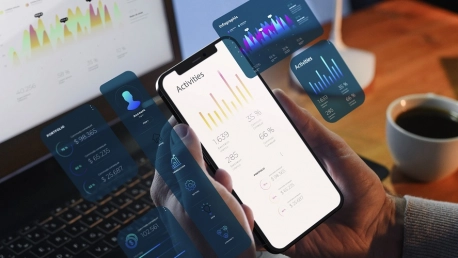In 2024, work is no longer defined as a 9-5 job confined to the office. With mobile devices, we’re able to join Zoom calls while sitting in coffee shops, generate invoices on the go, and respond to customer queries via CRM platforms while on the beach. A mobile-first approach to Software-as-a-Service (SaaS) design and development befits the fluid and robust post-covid working environment.
WhatsApp is used for communication just as much as Teams, and Outlook for Mobile has been a staple for employees for years now. With almost 50% of the global population having access to smartphones, business operations have migrated from desktops to laptops to mobile devices.
It comes as no surprise, that SaaS providers have found immense success in migrating their tools to mobile-friendly platforms, and others still have found that a mobile-first approach yields the most benefits for their products and services. Let’s take a look at why mobile-first SaaS design is gaining popularity.
Mobile-First Design Gains Popularity
With the widespread accessibility of mobile devices like smartphones and tablets, the world of work has once again undergone a revolution. We’re accustomed to having every app we need at our fingertips, and work has followed suit. What was once considered the domain of the “work computer” has found its way onto our phones, from Outlook to Teams, Skype, and Zoom. All the tools we need to get through a day of work successfully are no longer confined to our desktops. Our “everything-on-the-go” culture has allowed us to do, well, everything on our phones, and the Cloud has been a major enabler for this.
Responsive design, a precursor to the preference of mobile-first design, became largely popular throughout the 2010s. In responsive design, developers use fluid grids and flexible images along with CSS media queries to enable websites to adapt to various screen sizes and orientations (landscape vs portrait). Responsive design requires designers to prioritize content and essential features, leaving additional features for the larger screens.
Mobile-first, however, is more closely related to progressive enhancement. This design is considered progressive because users with older mobile devices and fewer features can still access a website, but those with newer browsers and feature-rich devices can enjoy the full spectrum of offerings.
Mobile-first design refers to a developer practice that starts with the mobile user experience in mind and then scales up to include larger screens. With mobile use steadily increasing and employees expected to have smartphones to complete work, mobile-first SaaS tools are gaining popularity concurrently. It is, however, important to note that a mobile-first approach for SaaS companies will always be guided by the product and its target audience.
It’s impossible to imagine every SaaS tool adopting a mobile-first approach, but the trends show that mobile access for apps and tools is on an upward trajectory and will continue for the foreseeable future. When Adobe Photoshop was launched in 1990, exclusively for Macintosh customers, it would have been difficult to imagine a future where Photoshop Express would be available for download on the Play Store and App Store. The lesson for developers and product owners is to consider that while your product might primarily be used on desktops, that could change. Thanks to the proliferation of mobile design and editing software like Canva, legacy SaaS tools like Photoshop are forced to adapt to remain relevant to different audiences.
Benefits of Mobile-First SaaS Design
There are several benefits to utilizing a mobile-first approach to SaaS development, chief among them the growing number of people using mobile devices for work-based operations. Let’s take a look at some of the outstanding benefits of mobile-first design for SaaS products:
Competitive advantage: Mobile use of SaaS products is on the rise, and companies looking to capitalize on this are advised to explore a mobile-first approach, where applicable. Companies like Zoho have demonstrated the benefits of adapting to the evolving needs of clients and have created mobile-first versions of their products. For businesses on the go, Zoho enables users to respond to customer queries, generate invoices, and generally manage operations in real time.
Accessibility: Mobile-first SaaS products offer users greater accessibility, which is an important aspect of business. Responsive design allows content to adapt to different screen sizes, and scalable fonts give users the ability to adjust font size according to their needs.
Improved SEO: With over 60% of all searches originating from mobile devices, Google’s algorithm prioritizes mobile-friendly websites. SaaS companies that have a mobile-first approach increase their visibility and rank higher on search engines.
Challenges with Mobile-First Design in SaaS
While there are several benefits to mobile-first design in SaaS, there are a number of challenges, which include:
Assorted devices: Mobile devices include tablets, iPads, and cell phones, each with its own operating system. Creating software that works consistently across different products can be a challenge.
Smaller screens: Mobile devices typically have smaller screens than desktops or laptops, limiting the functionality and amount of information displayed.
Different usage patterns: Developers, who use a mobile-first approach, have to be cognizant of the fact that users operate in various contexts. This means that apps have to be adaptable to different scenarios.
Slow Internet: Internet latency can deeply impact a user’s experience of a SaaS product, and this is likely more common with mobile SaaS, as users operate on-site and often outside of Wi-Fi networks. This results in poor performance and frustration.
Battery life: Unlike desktops, mobile devices have a much smaller battery life, which can be impacted by SaaS products. Developers need to be mindful of creating energy-efficient apps to preserve battery life on user’s devices as much as possible.
Scalability and responsive design are important aspects of mobile-first SaaS product development that can assist in circumventing these challenges. Responsive design will ensure that the app can easily orient to different screen sizes, while scalability manages the application’s traffic and usage ability.
The entire premise of the mobile-first design is the prioritization of the user experience on a mobile device, which requires developers to optimize the product by focusing on essential features and functions, as well as speed and performance.
Examples of Mobile-First SaaS Design
Some examples of companies that have successfully implemented a mobile-first design in their SaaS products:
- Calendly is a booking app used to schedule events, meetings, and appointments while sharing users’ availability.
- Notion enables collaborative note-taking and facilitates the sharing of ideas, task management, project management, and bookmarking.
- Figma’s mobile app provides users a platform for collaboration and creativity, utilized by graphic, UX, and UI designers.
- HubSpot Mobile App enables businesses to handle inbound marketing, sales, and customer service queries from their mobile devices.
- Zoom is one of the most popular SaaS applications, and its mobile app brings the power of video conferencing technology to mobile devices.
These SaaS companies are outstanding examples of meeting customers’ needs by iterating their desktop applications to mobile-first designs. Each of these apps provides users with a frictionless, seamless experience across devices, increasing accessibility, flexibility, and user engagement.
Concluding Thoughts
To remain competitive in a mobile-dominated market, SaaS companies need to adopt a mobile-first approach. Employees are increasingly using their mobile devices in business operations and the SaaS tools we regularly employ need to keep up with the evolving demands of the working world.
A mobile-first approach to SaaS is beneficial to both the business and its users; engagement and retention increase, customer loyalty and satisfaction improve, and companies are well-positioned as innovative industry leaders.
Mobile use is steadily increasing and SaaS companies that want to stay ahead of the curve need to prioritize the mobile user experience; this improves SEO and visibility, provides a seamless experience to users, and provides greater inclusivity and accessibility.









